by Joe Domaleski | May 14, 2024 | Blog, Business, Columnists, Community, Front Page, News Center, Opinion, Top News
As newlyweds back in 1994 (yes, later this year we will celebrate 30 years of marriage), Mary Catherine and I were given a book recommendation to check out: “The Five Love Languages” by Dr. Gary Chapman. The book rapidly gained popularity in Christian circles (Dr. Chapman was a Baptist pastor) before crossing over into the general book market and entering the NY Times Bestseller list. We received a copy of the book, but honestly, I didn’t read it until a few years later when we attended a marriage retreat for newlyweds. One of the sessions at the retreat was about the love languages. It was a great session, which inspired me to read the book.
If you haven’t read the book, here’s a quick summary. Dr. Chapman proposes that there are five ways in which romantic partners like to receive and express love.
- Words of affirmation – giving compliments and expressions of appreciation to your partner
- Quality time – spending time with your partner by giving your undivided attention
- Gifts – presents and other items you know your partner will like
- Acts of service – doing things, like chores, for your partner without being asked
- Physical touch – nonverbal communication like hand-holding, hugs, and forms of romantic engagement

My wife’s love language is “acts of service”. Here I am about to make her happy by trimming up tree limbs. Photo/Joe Domaleski
Although these five expressions of love were not scientifically researched in a peer-reviewed journal, the essential message resonated with many people, which helped propel the book onto the bestseller list. Chapman recommends that couples become aware of their love language and that of their partner. Doing so helps to foster greater intimacy and happiness in a relationship.
One thing he encourages people to do is not to assume that everyone has your love language. We tend to express love as we like to receive it, and that may not line up with your partner’s love language. As an example, I don’t mind sharing that my love language is “words of affirmation.” A simple “thank you” or “I’m proud of you” fills up my love bank. Mary Catherine’s love language is “acts of service.” Instead of telling her that I love her, if I go cut the grass without being told, she really likes that.
By the late ’90s, most people in my circle of friends were quite familiar with the love languages, and I noticed that many people began to apply the concepts outside of a romantic relationship. Indeed, I don’t know many people over the age of 40 who haven’t heard of the love languages. Dr. Chapman wrote several versions of his original book, applying the concept of love languages in different scenarios. In 2011, he co-wrote with Paul White “The Five Languages of Appreciation in the Workplace,” tailoring the message to a workplace environment.
I’ve personally used the “Five Languages” in the workplace, and I do think it helps people to understand what motivates and inspires themselves and others. At work, I’ve talked about the five languages, and it’s helped me to better understand people and be understood so that work relationships can be strengthened. So that there are no misunderstandings, I’m going to adopt the same terminology as Dr. Chapman, and we’ll call these the “five languages of appreciation” instead of “love.”

One of the most unique and memorable gifts of appreciation I’ve received. Southern Conservation Trust former-Executive Director Katie Pace and Board Chair Brian Cooper gave me these socks and a plaque for my five years of service as Race Director of the Run the Ridge 5K in 2023. Photo/Mary Catherine Domaleski
Words of affirmation – written or verbal accolades that are specific and timely. “Thank you for handling that difficult client situation this morning. I appreciate your willingness to go the extra mile.” Sometimes a one-on-one expression of gratitude is called for, and at other times, a more public recognition is more effective. The key is to make the expression of affirmation authentic and personal, not a generic “good job.”
Quality time – giving someone your undivided attention is always a good thing, but for some people, this means the world to them. Showing up, listening, engaging, and “being in the trenches” with them is very important. People who like quality time struggle with working remotely and tend to like being around others. COVID was an especially difficult period for quality time people. Periodically going out to lunch or having coffee with your co-worker can reinforce a positive relationship.
Acts of service – don’t tell me, show me how much you care by helping out. Acts of service people are motivated when you do things without being asked. Pitching in to help, offering assistance, and doing your part motivates acts of service people. Not doing your part, avoiding tasks, and “disappearing” does quite the opposite.
Gifts – many people are motivated by gifts, especially personalized ones. Plaques, certificates, gift baskets, cards, company “swag,” and other tangible forms of appreciation motivate a gifts person. Most people like gifts, but for “gifts people,” they really, really like the physical tokens of appreciation. You can normally identify these types of people because their office or workplace is adorned with trinkets accumulated over the years.
Physical touch – of all the original love languages, this one is probably the trickiest to adopt to the workplace. People who appreciate physical touch enjoy a firm handshake, fist bump, or high five. While maybe not appropriate everywhere, we live in the South, and I know many people, particularly women, are huggers. As a man, I try not to presume and let a woman initiate a hug if that’s okay with her. I know many men who are huggers as well. Sometimes I’ll give a thumbs-up or other visual form of “virtual touch” affirmation as a way to express the gesture without actually touching someone. Respect boundaries and don’t touch anyone who doesn’t want to be touched.
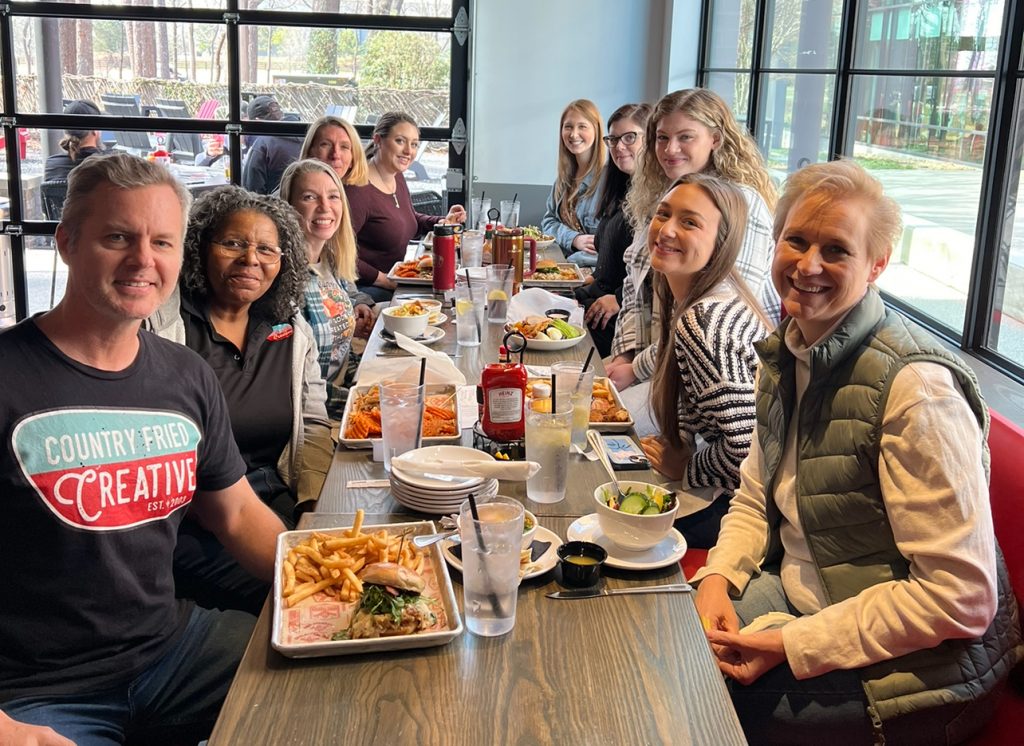
Company lunch earlier this year where we recognized the services of two departing team members with quality time, gifts, and words of affirmation. Photo/Joe Domaleski
Over the years, I’ve found the love languages to be a great way to express and receive affirmation from family, friends, and even co-workers. Most people are not exclusively one language type or another, but most people do have a preference for what’s most meaningful and least meaningful to them. In the workplace, these expressions of affirmation do not have to be just between managers and subordinates but also apply to peer relationships. If you’re in sales, understanding your customer’s language type can help you develop a better relationship with them. If you manage people or teams, it’s essential to understand someone’s language type.
So you already know my love language is “words of affirmation.” What’s your love language?
[Joe Domaleski, a Fayette County resident for 25+ years, is the owner of Country Fried Creative – an award-winning digital marketing agency located in Peachtree City. His company was the Fayette Chamber’s 2021 Small Business of the Year. Joe is a husband, father of three grown children, and proud Army veteran. He has an MBA from Georgia State University and enjoys sharing his perspectives drawing from thirty years of business leadership experience. Sign up for the Country Fried Creative newsletter to get marketing and business articles directly in your inbox. You can connect with Joe directly on LinkedIn for more insights and updates.]
by Joe Domaleski | May 7, 2024 | Blog, Business, Columnists, Community, News Center, Opinion, Top News
There seem to be two schools of thought when it comes to motivations for starting and running a business – chasing dreams or dollars? Like many things in life, I guess the answer to that question depends upon who you ask. I took the leap into entrepreneurship twenty-one years ago, so I’ve had plenty of time to reflect on the question.
Starting my own business was not just a career decision; it was the fulfillment of a lifelong dream. My father was an entrepreneur, and watching him start and grow several businesses inspired me (and scared me). In my first column for this newspaper, I shared my reasons for starting my business.
“Money is important to keep the lights on, but spending time with family, supporting our local community, and helping others is why I started the business almost twenty years ago.”
Well, those are the reasons I started the business, but why do I keep it going? I’ll be honest with you, now that the business has grown and lasted for over twenty years, I’ve been asking myself that question more and more these days. Do I keep it open to chase dreams or dollars?
When I started my venture in 2003, I was fueled by a dream. The idea wasn’t just to create something of my own but to build a business that aligned with my values and interests, and something that would make a positive impact on the local community. The dream was about autonomy, creativity, and personal growth. It was thrilling, invigorating, and yes, at times, downright terrifying.
But here’s the thing about dreams—they don’t pay the bills, at least not initially. When I first started up, we went over three months before I landed a client, and it took a solid year before I was breaking even. Money was not the initial motivation for starting my business. Because I bootstrapped the business and funded it with my own money, I was “all in.” There’s a big difference between spending your own money and someone else’s money when you’re starting up and running a business.
When thinking about dreams vs. dollars, the word “balance” comes to mind. There’s a delicate balance between making decisions that ensure financial stability, and the often riskier moves that our dreams require. In the early years, there were countless sleepless nights spent worrying whether I made the right decision. Even now, as many of my friends are retired and “set,” I wonder if I made the right decision.
Over the years there have been months where the financials looked bleak, and the temptation to give up and get a ‘real job’ was overwhelming – especially during the big recession of 2010. We almost lost it all, and it really tested our family. Many businesses did not make it, but we did. I don’t give up easily – which frustrates some and inspires others.

Sketching out the nonlinear path of my dreams at Backstreet Arts in Newnan. Photo/Erica Caetano
Despite the struggles, here I am, two decades later, still at the helm of our business – selling, helping clients, working with great employees, and mentoring interns. Why? Over the years, I’ve learned that chasing a dream provides something that dollars can’t buy—purpose. Each challenge faced, and every hurdle overcome, brought with it a sense of achievement that money could never match. It’s been said that a leader should lead with head, hands, and heart. I believe the greatest of these is HEART and there’s some Biblical basis for feeling that way.
However, I can’t romanticize the pursuit of dreams without acknowledging the importance of financial planning and management. Money is a crucial enabler that allows us to continue chasing dreams. As my business grew and I hired employees, money became even more important because other people are then basing their livelihood on the success of the business. Unlike most marketing agencies (particularly those that build websites), I’ve tried really hard to create local jobs and not outsource them. It’s not cheap to live in our community.
I get asked for free stuff all the time by new businesses and nonprofits starting out. My first inclination is to follow my heart and dreams to say, “Yes, we’d love to help you for free.” If I were independently wealthy, I’d probably do that. But I’m not, and my staff deserves to earn a living. Even though they could make more money working elsewhere, they are also committed to the dream.
People don’t value free stuff anyway. Over the years, we’ve helped many people and organizations get off the ground by charging them “starter rates” well below our actual cost. Many of those same organizations have grown, at least partly because we helped them get off the ground. Yet, when they finally have the financial resources and go “big time,” many move on – and it hurts. Sometimes they hire a “big Atlanta agency” or a national company to replace us – indeed this has happened without any acknowledgement that we helped them start. It never feels good, but it doesn’t diminish the dream. I believe it’s always the right time to do the right thing, even if it’s not always appreciated or acknowledged.
But at other times, our work is acknowledged and appreciated, which means the world to me. Just this past weekend, a client approached me at a social function and asked if it was okay to “talk about work.” Although I wasn’t sure what she was going to say, I braced myself for something negative and said, “Sure.” She said, “Joe, you have been undercharging us. I want you to increase our monthly bill.” Wow! It doesn’t happen often, but when it does, it validates the “dream.”
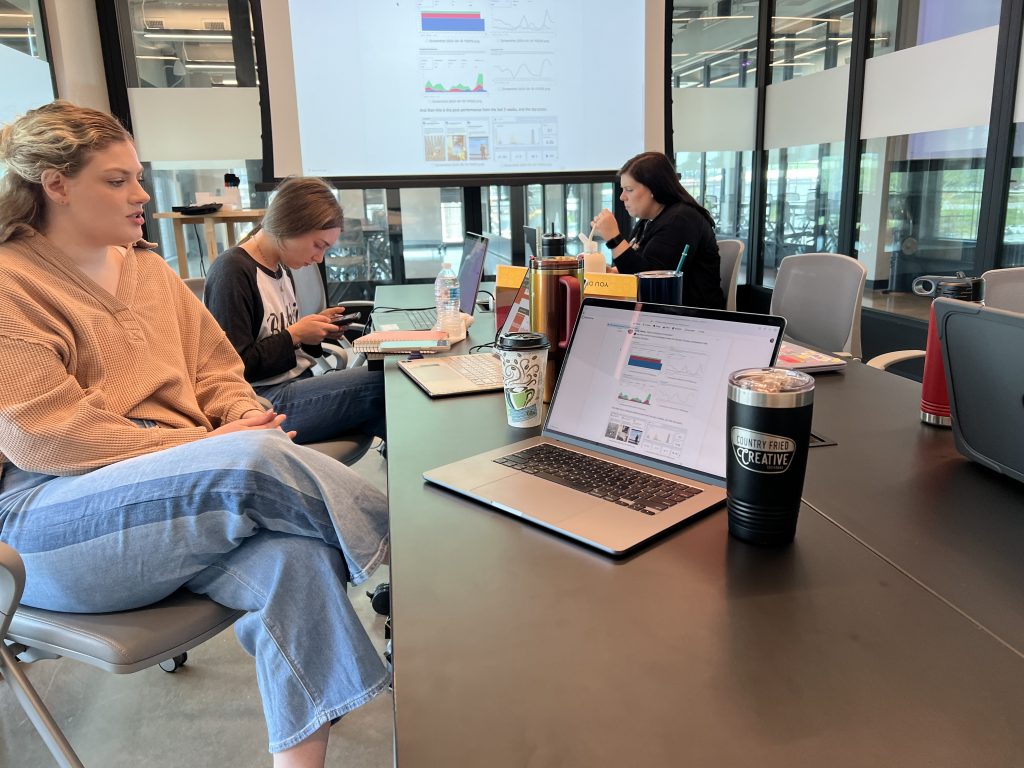
CFC team members – Kylee Veres, Mia Scarbrough, and Hollie Holder reviewing “the dream” during a recent marketing meeting at Trilith. Photo/Joe Domaleski
Let’s be realistic. Most people don’t ask for price increases. Quite the opposite, the trend is for people to ask for more at a lesser price. We want to be helpful, but we also have to run a business. It’s a trade-off finding the intersection between where passion meets profitability. We’re constantly tweaking our dream to help people by balancing purpose and profits. We haven’t increased our prices that often over the past twenty years. Before we consider a price increase, we always focus on internal cost reductions because we don’t want to burden our clients. Yet, sometimes we have to adjust financial parameters in order to sustain our dream for the long run. Beware of companies that are priced so low that they can’t stay in business.
So, to those wrestling with the decision of whether to chase dreams or dollars, my advice is to weigh your personal circumstances and seek balance between those two goals. Be careful if your only goal is to make money – it’s hard to find loyal customers and employees if everything is being managed by a spreadsheet. In today’s data-driven world, people matter more than numbers. Be careful of seminars, consultants, and groups that promise to help you make more money and work less. Despite the seductive allure of vacations and lots of money, I don’t know a single successful business person who doesn’t work hard. That hard work is often fueled by passion, not profits. For me, profits follow passion and not the other way around.
What do you value more – dreams or dollars? What are you willing to sacrifice? It’s not the same for everyone. You might find that your dream can adapt, evolve, and still thrive within a financially sustainable framework. Or, you might decide that certain dreams can wait while you build your financial base.
In my case, the answer has evolved over the years. I think it’s pretty obvious by now that money is not the most important thing in my life, and, frankly, I avoid relationships where it is. Even though I’m a dreamer at heart, I believe in chasing dreams smartly. After all, what is the value of a dream if it can only live in your imagination?
Hey leaders – dream big, but plan carefully. Strive to make your dream resilient enough not only to survive but to thrive. After all, the sweetest successes are those that are dreamed first and then diligently pursued with both heart and mind. What are your dreams for the future and can you make money along the way?
[Joe Domaleski, a Fayette County resident for 25+ years, is the owner of Country Fried Creative – an award-winning digital marketing agency located in Peachtree City. His company was the Fayette Chamber’s 2021 Small Business of the Year. Joe is a husband, father of three grown children, and proud Army veteran. He has an MBA from Georgia State University and enjoys sharing his perspectives drawing from thirty years of business leadership experience. Sign up for the Country Fried Creative newsletter to get marketing and business articles directly in your inbox. You can connect with Joe directly on LinkedIn for more insights and updates.]
by Joe Domaleski | Apr 30, 2024 | Blog, Business, Columnists, Community, Front Page, News Center, Opinion, Top News
Ihave been feeling nostalgic lately. Several things going on in my life have me reflecting upon the past and thinking about the future – especially as it relates to my life experiences with STEM – Science, Technology, Engineering (or Entrepreneurship), and Mathematics. This is going to be one of my longer articles, but hopefully, it will be fun as I stroll down memory lane. Let’s start with some personal history for context.
I was born in 1967, which places me at the front end of Generation X, normally defined as those born between 1965-1980. Some of you reading this article may think I’m old, and others may think I’m still young. I guess that means I’m somewhere in between. I don’t mind being middle-aged, with all that comes with it.
My parents are young; they had me when they were 20. After my father’s service in Vietnam, he started several businesses, and that’s probably where I got my own entrepreneurial spirit. He was the first person on his side of the family to finish college and even earned a Master’s Degree from Georgia State University (GSU) in 1979. We have three generations of GSU scholars in our family. My Master’s Degree is from GSU (MBA ’93), and my daughter Alex completed her Master’s Degree from GSU a few years ago. My younger brother Chris has his doctoral degree from GSU.

Three generations of GSU graduates. (L-R) Joe Domaleski MBA ’93 with my soon-to-be wife Mary Catherine and late Mother-in-law George Ann; my daughter Alex Domaleski MS ’20; and my father Ed Domaleski MA ’79. Photo/Joe Domaleski
Two things happened after my father completed his post-graduate degree in 1979 that influenced my life path in technology. First, Dad accepted a position as a college instructor at DeKalb Community College in Clarkston. It’s still there but is now known as the Clarkston Campus of Perimeter College – GSU (the connection to GSU again). We moved to the area and settled in Stone Mountain, where I attended Clarkston High School (Class of 1985). Like many kids, I wanted to be like my dad and thought it was cool to be a college instructor. The importance and prominence of education made a big impact on me. My dad was the “cool instructor,” and I wanted to be like him.
The second thing that happened around that same time was my introduction to computer technology. Dad taught business data processing, and I was fascinated. Not only was I fascinated by the technology (computers and handheld calculators), but also by the application of technology for solving business problems. He initially used mainframe computers. In fact, I remember going to the computer lab with him to process computer “punch cards” to run programs. That didn’t last long, however, because the personal computer arrived and changed everything. At the college, he used a TRS-80 and an Apple II (my first introduction to Apple). Eventually, he saved enough money and bought a computer for the house—the Osborne 1 “suitcase” computer. I still have it, and it works!

The Osborne 1 portable computer. Originally released in 1981, this picture was taken in 2024. The computer still works! Photo/Joe Domaleski
First released in April 1981, the Osborne 1 was the first commercially viable portable computer. It ran the CP/M operating system, which was the predecessor of Microsoft’s Disk Operating System (MS-DOS). Having that computer at home allowed me the opportunity to learn, experiment, and innovate with computer technology firsthand. I feel strongly that kids should have access to resources to be creative and learn on their own. Having a family that emphasized the importance of learning and provided access to the tools needed made all the difference in the world to me.
Now that you know a little about my background, please indulge me as I continue my stroll down memory lane by considering several topics of personal interest in STEM that I have enjoyed and experienced over the years.
Application Software
The Osborne 1 came packaged with the very first “office suite” of software, including WordStar word processor, SuperCalc spreadsheet software, and dBASE II database system. Google Workspace and Microsoft Office are based on those early software systems. Business users were amazed at the power of those early applications, but I was just a teenager at the time, so I wanted to “tinker.” The Osborne 1 also included CBASIC, which gave me the option to explore BASIC computer programming.
Computer Programming
BASIC was my first computer programming language. I used it on the Osborne 1 at home, on the Apple II in my father’s computer lab at the college, and at Clarkston High School. Under the mentorship of Coach Paul Horsley, Clarkston started an innovative new class to give high school kids like me access to computer programming.
I was amazed at all the things I could tell the computer to do using BASIC. To this day, I consider computer programming my original computer science interest. Once I mastered BASIC, I taught myself 8080 assembly language, PASCAL, and COBOL.
Upon graduation from high school, I enrolled at North Georgia College (now University of North Georgia) in Dahlonega. The Computer Science program was part of the Department of Mathematics, so my studies included both fields. Many of the computer classes were taught by the late Mr. Ernie Elder, who nurtured our sense of exploration as we studied algorithms, computer architecture, and other esoteric programming languages like PROLOG, APL, and C. Dr. Kathy Sisk was also a very positive influence on my studies in math and computer science. Thank you, Ernie and Kathy. I was on an ROTC scholarship at North Georgia and was one of the few cadets who had their own personal computer in the barracks.
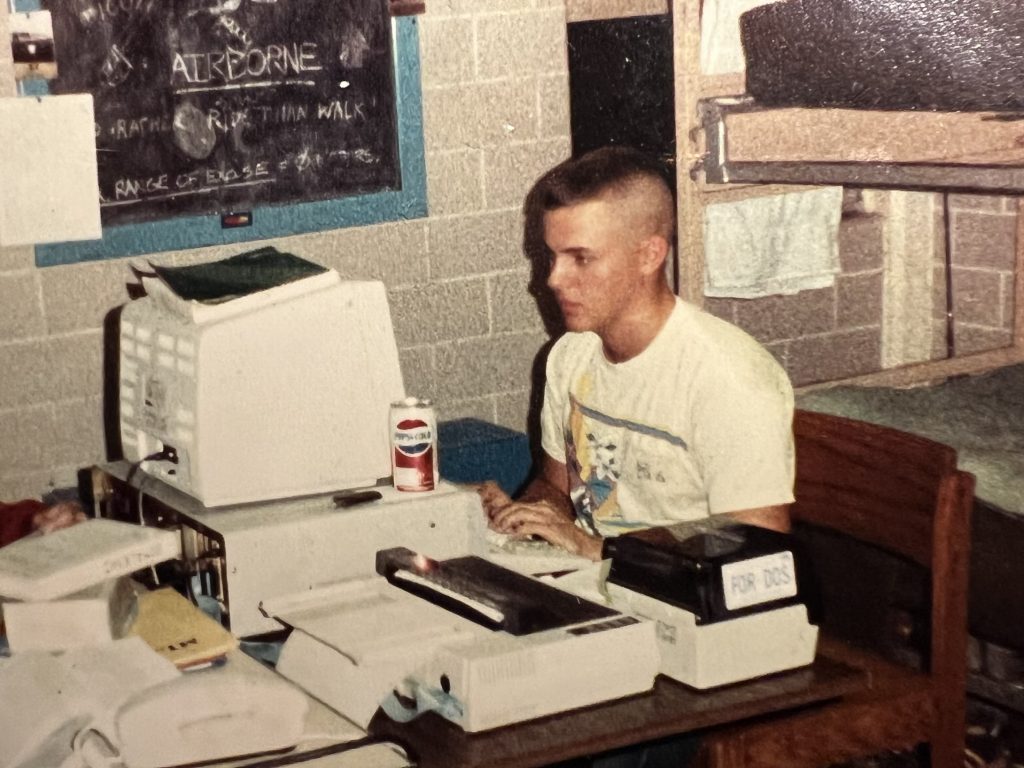
The author programming an IBM PC computer back in 1987. At the time he was a ROTC Cadet at North Georgia College (now UNG). Notice the dot matrix printer and the box of 5 1/4″ floppy disks. Photo/Joe Domaleski
Computer programming has always been a sort of “home base” skill for me, and those skills were further developed later in life when I learned HTML, CSS, PHP, JavaScript, and most recently, Python.
Mathematics
Computer science has its origins in math. I think that students who have a solid foundation in math will find the rigor of computer science easier. One of the earliest influences on my mathematical studies was Sister Bernadine, a Catholic nun who taught an 8th-grade accelerated math class at Our Lady of the Assumption Catholic School, where I attended grades 1-8. To this day, she remains one of the best math teachers I ever had. We learned pre-calculus in 8th grade, and she made it fun. Having that early exposure to advanced math in 1980 helped me understand the mathematical underpinning of modern computer algorithms.
In high school, I continued to nurture my interest in math but also became interested in science as a form of applied math. Trigonometry and calculus made more sense because of physics, and vice versa.
My mathematical journey went much deeper in college because of the curriculum associated with the computer science degree. I was given the opportunity to explore a wide variety of topics such as statistics, probability, linear algebra, discrete math, calculus, and numerical analysis. Linear algebra, in particular, did not seem very relevant at the time but might be one of the most important topics as it forms the basis for neural networks that power generative artificial intelligence (AI). Knowing how matrices and vectors work put me at an advantage when considering the strengths and weaknesses of different AI approaches. Math matters.
Most of my math in graduate school was based on financial analysis using interest rate calculations and net present value. We did use statistics in analysis (data summaries), calculus in economics (maximum/minimum), and linear regression for decision sciences (which I’ll come back to later).
Science
You can’t talk about math without talking about science and vice versa. Going back to middle school, I’ve always enjoyed science and participating in science fairs. Electronics, physics, and astronomy were always my favorites. Physics, in particular, really interested me, and that ended up being my minor at North Georgia. During my studies, a book came out that really inspired me—”Chaos: Making a New Science” by James Gleick. This book, released in 1987, introduced the world to chaos theory and the work of the Santa Fe Institute.
Simply stated, chaos theory (or complex non-linear dynamical systems) is an interdisciplinary field that brings together math and physics to study systems that appear to be random (or chaotic) but are not. Attributes of chaotic systems include sensitivity to initial conditions, self-similarity, determinism, feedback loops, fractals, and self-organization. Examples include fractals, weather, flocks of birds, the spread of fire, economies, viral behavior on the internet, and so forth. Perhaps you’ve heard of the “Butterfly Effect“?
In 2015, the Santa Fe Institute Complexity Explorer program began to offer some online courses in a variety of related complexity topics. The classes weren’t easy and required the use of statistics, calculus, and specialized programming languages like NetLogo for modeling agent-based systems. I had a blast. Here’s a screenshot of one of my R programs to plot the famous “logistic map.” Fun stuff, to me at least.

Logistic Map program I wrote in the R Programming Language running on my iPad. Photo/Joe Domaleski
Personal Computers
Ever since Dad brought home the Osborne 1 in 1982, I’ve had access to a personal desktop computer. Over the years, the size of my computers has decreased as their processing power has increased. At the time in the ’80s, it was quite a revolution to put the power of mainframe computers on everyone’s desktop. Issues about data access, security, standardization, and support still create struggles for the modern enterprise. Yes, back in the ’80s and early ’90s, many people in Information Technology opposed giving users that much power. Echoes of that battle are still being heard over the use of portable computing devices like smartphones and tablets at work and in the classroom. Although it’s not without issues, I do believe having access to personal computing devices is a good thing, even though I like to unplug once in a while too.
Expert Systems
After learning how to program computers in the early ’80s, I began to wonder about ways to make computers even more helpful. I first became exposed to the term “Artificial Intelligence” in a mid-’80s article in the now-defunct “BYTE” computer magazine. The article talked about ways to codify human knowledge into so-called expert systems to solve problems. A special declarative programming language called PROLOG (Programming in Logic) was developed to do just that. Developers would code rules and facts in PROLOG, and the computer would infer solutions. It worked a lot like those logic puzzles and games like Clue. You lay out all the facts and try to determine “who done it.”
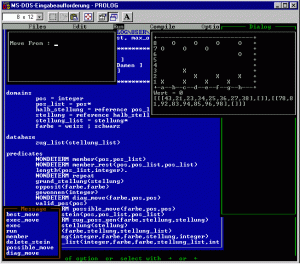
Example Turbo Prolog source code running on MS-DOS. Photo/Frank Bergmann, CC-BY-SA-4.0
I learned about PROLOG at North Georgia in an Introduction to Programming Languages survey class. I continued experimenting with it using a derivative language called Turbo Prolog. Somewhere in my house is a copy of Turbo Prolog on a floppy disk. Although fun for solving simple problems, it became readily apparent that coding up all the rules was very labor-intensive work. If an expert system was to help solve problems, then knowledge engineers would have to code all known knowledge about the problem as rules. Interest in expert systems began to die down in the ’90s although marketers continued to use that term as a buzzword all the way up to 1999 when the so-called “millennium bug” became the focus of interest.
Neural Networks
I had never heard of a neural network until I watched Star Trek: The Next Generation on TV. In that show, the android “Data” had a positronic brain powered by a neural network. Knowing that Star Trek liked to maintain a basis in science, I looked up the term and discovered that it was a real thing. Originally conceived in 1957 as a “perceptron” by Dr. Frank Rosenblatt, it was a way to pattern a computer architecture after the neurons in the human brain.
It’s beyond the scope of this article to recount the history of neural networks, but there’s plenty of information available online, including this summary by Wikipedia. Neural networks fell out of favor during the “AI winter” and didn’t really re-emerge until the late ’80s as the limits of expert systems were beginning to be discovered. An innovation using calculus to perform backpropagation allowed neural networks to “learn” and optimize.
Neural networks popped back up on my radar screen in graduate school. As part of my MBA curriculum, I had to take a Decision Sciences class by a young professor named Dr. Alok Srivastava. Decision science is sometimes known as forecasting, analytics, and data science these days. Regardless of what you call it, it’s really the application of mathematical tools to help make business decisions. Before “big data,” we did a lot of that analysis using spreadsheets, this time Lotus 123 on a personal computer. After class one day, I mentioned to Alok that I knew C programming and thought some of our spreadsheet assignments would be better handled by a computer program. He pulled me aside and asked me, “What do you know about Backpropagation Neural Networks?”
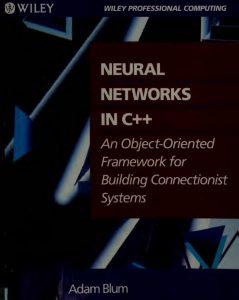
The book ignited my interest in AI – Neural Networks in C++ by Adam Blum (1982). Photo/Joe Domaleski
We collaborated on some financial and economic data analysis using neural networks written in C. One of the early reference books we used, because textbooks still didn’t have much to say on the subject, was a new book entitled “Neural Networks in C++, An Object-Oriented Framework for Building Connectionist Systems” by Adam Blum (Wiley, 1992). I still have a physical copy of the book somewhere on my bookshelf. What we learned then, and is still true today, is that neural networks are excellent at pattern recognition. Based on linear algebra, statistics, and partial derivatives (calculus), neural networks have the seeming ability to “self-organize” given proper training—much like a human. Alok encouraged me to continue my studies to pursue a Ph.D., but I opted to enter the business world with my MBA, get married, and start a family. Unfortunately, Alok passed away in 2010 due to complications from diabetes.
Honestly, I had forgotten much of that early work I did in neural networks because of the rise of the Internet in the late ’90s. Much of AI research stalled out again in another “AI winter” as everyone became fascinated with the internet and web-based technologies. In fact, even the term “AI” had some ridicule associated with it as a failed promise going all the way back to the ’50s. Little did we know that neural networks would resurface later to power modern AI including generative AI such as ChatGPT.
Internet
There’s no doubt that the Internet has had a major impact on my life and the lives of just about everyone. My first email account was a GSU account back in the early ’90s when most internet usage was restricted to government and academic use. Outside of school, we used dial-up modems and computer bulletin boards (subject for another article). Before there was the World Wide Web (simply “the web” now), I used something called Gopher, “go fer,” to retrieve documents and information on the internet from the GSU computer lab. Gopher was a text-only, menu-based system. It fell out of favor when HTTP, HTML, and the web spawned the creation of websites.
Being a book and information nerd, I was fascinated by having the ability to sit at a computer and look stuff up using Gopher and then web browsers. To this day, I still love to go down “rabbit holes” by looking up esoteric facts and information online. This newspaper website, where you are reading my article, was one of the first commercially viable websites in Fayette County and the first local newspaper to go online.
We should probably make a distinction between several related terms. The Internet is a network that connects computers all over the world. The web is a system of websites (residing on computer servers) containing web pages to view information and handle transactions. The web is accessible through the internet. The internet is also used to send/receive electronic mail (email) and pass data between applications on your computer, phone, tablet, and other devices.
Web Projects
During much of the ’90s, I served in various consulting roles related to the business application of technology. Beginning with the commercialization of the Internet and the Atlanta Olympic Games in 1996, I decided to steer my career in the direction of web project management. The Olympic website was built on IBM technologies. As one of the first IBM-certified Internet Architects, I became an expert in developing large-scale e-commerce websites in the late ’90s and especially into the early 2000s.
I feel strongly that a project manager should have the ability to “do the work” and not just direct it from afar. Not everyone agrees with that philosophy. Maybe it comes from my military experience where everyone carries a weapon. Regardless, I taught myself HTML (the language of the web) and TCP/IP (the architecture of the Internet) so that I could be a better web project manager. To this day, I can code websites by hand using a simple text editor. I don’t do it often, and my staff prefers it that way!
In fact, I enjoyed building websites so much that in March 2003, I left the corporate world to start my entrepreneurial journey by building websites.
Entrepreneurship
You can read more about why I started my business in my very first article. As I’ve said many times before, running a business has been both the hardest thing I’ve ever done and one of the most rewarding. Nothing I learned in business school or as a consultant fully prepared me for the ups and downs of running a business.
Now in our 21st year, I’m still learning things about running a business as I go along. Besides the points made in two previous articles: things I most like about running a business and the things I don’t like about running a business, two other insights have become apparent.
First, most people are not cut out to be entrepreneurs. The ones that are have to be driven by passion, not greed. There are a lot easier ways to make money besides starting a business. This is going to ruffle some feathers, but if your primary goal is to make money, do something else. If you have a dream and think you can make money chasing that dream—go for it. You will learn so much and help so many people along the way, but be prepared for disappointment and rejection.
Second, my business would not have succeeded without having a solid basis in technology. It’s true that the heart of our business is people—employees, clients, and supporters. However, our interactions wouldn’t work without great technology and the knowledge to use it. We literally use technology for everything we do in order to create outstanding marketing programs and campaigns for clients.

The author keeping all of the computers and technology going at the 2017 Fayette Woman Live conference. Photo/Cal Beverly
In short, I can trace quite a bit of my own entrepreneurial passion and drive back to tinkering with computer programming when I was a teenager. I had no idea at the time that the Internet and web would even come to pass, and now I own a company that offers that service. Lesson learned—we don’t know what the future holds or where life will take you. You may be doing things now that will be obsolete in the future and things that may not have been invented yet could become your livelihood. Let’s return to something from my early career that has resurfaced—AI.
AI and Neural Networks Revisited
Artificial Intelligence became fashionable again last year with the sudden appearance of generative AI in the form of ChatGPT and others in 2023. What’s old is new again. Ironically, it was because of the Internet that neural networks faded from the spotlight and then experienced a resurgence around 2010.

Programming AI algorithms using the Python programming language on my Mac. (2023) Photo/Joe Domaleski
The convergence of “big data” from the internet and faster processors in the form of GPUs has caused renewed interest in artificially intelligent applications. AI, often powered by neural networks, started showing up under the radar in things such as recommendation engines, mapping, image recognition, and data analysis. As I mentioned in a previous article, these types of AI were marketed as “smart” or “intelligent” systems due to the continued stigma associated with the term “AI.”
All of that changed again last year, and now AI is in the spotlight again. I think we’re all suffering from AI-overload. Truth is, no one knows where it’s heading. Will AI take over the world and make humans obsolete, or will it peak because of a flattening of the innovation curve and lack of training data?
As for me, I’m excited. Because of my life experiences, I’ve seen situations like this before when a disruptive technology seemingly shows up out of nowhere. I wasn’t alive during the industrial revolution, but most of my life has been spent as an active participant in the information revolution. When personal computers arrived around 1980, it took about a decade but things changed dramatically. Entire industries were created just as other industries died out. When the Internet and web came to be, it created enormous economic opportunity but also killed off other things like printed phone books (which used to be a billion-dollar business). Smartphones have combined the power of computers and the Internet to put a lot of power in everyone’s hands. Yes, the emergence of generative AI is huge, maybe one of the biggest things to ever face humanity, or maybe not. We don’t know.
The Future
Recently, I had the opportunity to interview a young data scientist for a possible internship position with my company. He will soon graduate with a Master’s Degree in data science and is exploring options. As we plan for expanding our range of digital marketing services into new areas, it’s important to bring in talent. During our discussions, I was very impressed by his enthusiasm for AI and data science. I told him that he reminded me of myself 30 years ago. He was surprised to find out that an old guy like me knew how to implement deep learning (a form of neural network AI) in Python. He also didn’t know that neural networks had been around for so long and that someone in the business community actually understood and used linear algebra and partial derivatives for marketing analysis. There’s no question that his skills are more current than mine, but it’s important for old guys like me to keep up with the young ones.
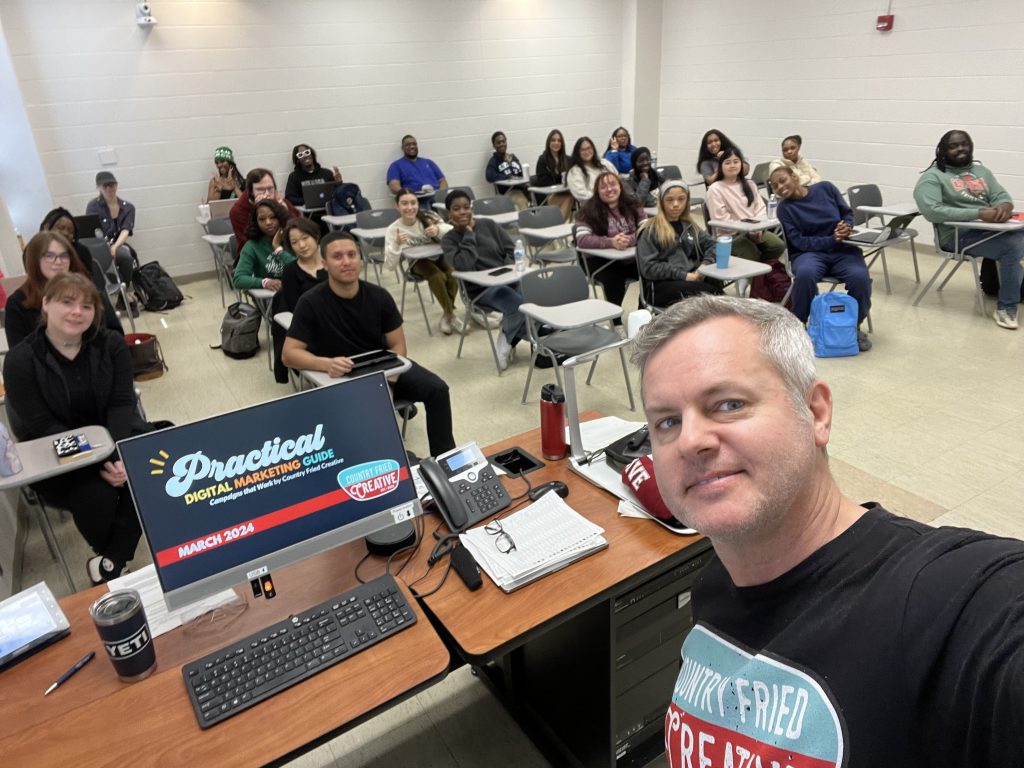
A dream come true. It only took 30 years, but I finally got to return to GSU to teach college in March 2024. Thanks to Matt Bramblett and the Robinson College of Business at Georgia State University for the opportunity to teach digital marketing to this group of future entrepreneurs. Photo/Joe Domaleski
As for me, I’m glad that my career had a firm foundation in STEM (Science, Technology, Engineering (and Entrepreneurship), and Math). A good solid STEM foundation can prepare you for life in ways that you can’t imagine. Even if AI can do a lot of the work for you, a solid foundation of knowledge in a human brain is essential to make sure the right questions are asked of AI and the computer-generated solutions are properly interpreted. For now, at least, AI can’t read our minds so we have to be able to guide it. STEM can help you do that.
Thank you to everyone who was a mentor or teacher to me over the years. Thanks also to all of the interns, colleagues, current and former employees who gave me the opportunity to share my experiences with you. How are you preparing yourself and those around you for the future?
[Joe Domaleski, a Fayette County resident for 25+ years, is the owner of Country Fried Creative – an award-winning digital marketing agency located in Peachtree City. His company was the Fayette Chamber’s 2021 Small Business of the Year. Joe is a husband, father of three grown children, and proud Army veteran. He has an MBA from Georgia State University and enjoys sharing his perspectives drawing from thirty years of business leadership experience. Sign up for the Country Fried Creative newsletter to get marketing and business articles directly in your inbox. You can connect with Joe directly on LinkedIn for more insights and updates.]
by Joe Domaleski | Apr 23, 2024 | Blog, Business, Columnists, Community, Front Page, News Center, Opinion, Top News
Last fall, I wrote an article about how I use Artificial Intelligence (AI) in my small business. The article proved to be quite popular and I was even interviewed about it by two local universities. That article was based on my past experiences as a math/computer science professional and recent experience using ChatGPT for most of 2023 with my digital marketing agency.
Six months have passed since that article was written. Many things have changed since then, and even more change is just around the corner. Fortunately, nothing I said in that article is wrong or obsolete (yet), but things change fast, and I felt it was time to provide an update.
AI is one of the top three topics clients and people in the community ask me about, with questions such as:
- Will AI take away jobs? Yes, it’s already happening, but it’s also creating them.
- Should I use AI for my marketing? Yes and no. It’s a great helper but not a replacement for human creativity. Use it like a personal assistant to help you.
- Should I replace my doctor, accountant, or lawyer with AI? No, because AI doesn’t know your specific situation and often gives bad advice, especially in complex situations. It also can’t explain it’s answers.
- Should I write blogs or emails exclusively with AI? No, because it’s just churning out old ideas without context or direct experiences. However, it can be a great writing assistant for idea generation and proof-reading.
- Should I generate images/videos with AI? Yes and no. Many AI-generated images/videos still look fake. However, it can help touch up images and videos. Be aware of AI-generated deepfake images and videos on the Internet.
- Can I write computer programs with AI? You mean you’re not already doing that? You have some serious catching up to do. Try it and you’ll see what I mean.
- How can I learn more about AI? That’s easy do these three things – 1. Read about it (see suggested books later in this article), 2. Try it out using ChatGPT, Gemini, or CoPilot, 3. Talk to others about how they’re using it.
- What’s in store for AI in the future? Glad you asked, this updated article will attempt to answer that question. However, no one really knows for sure and that includes the experts who created it.
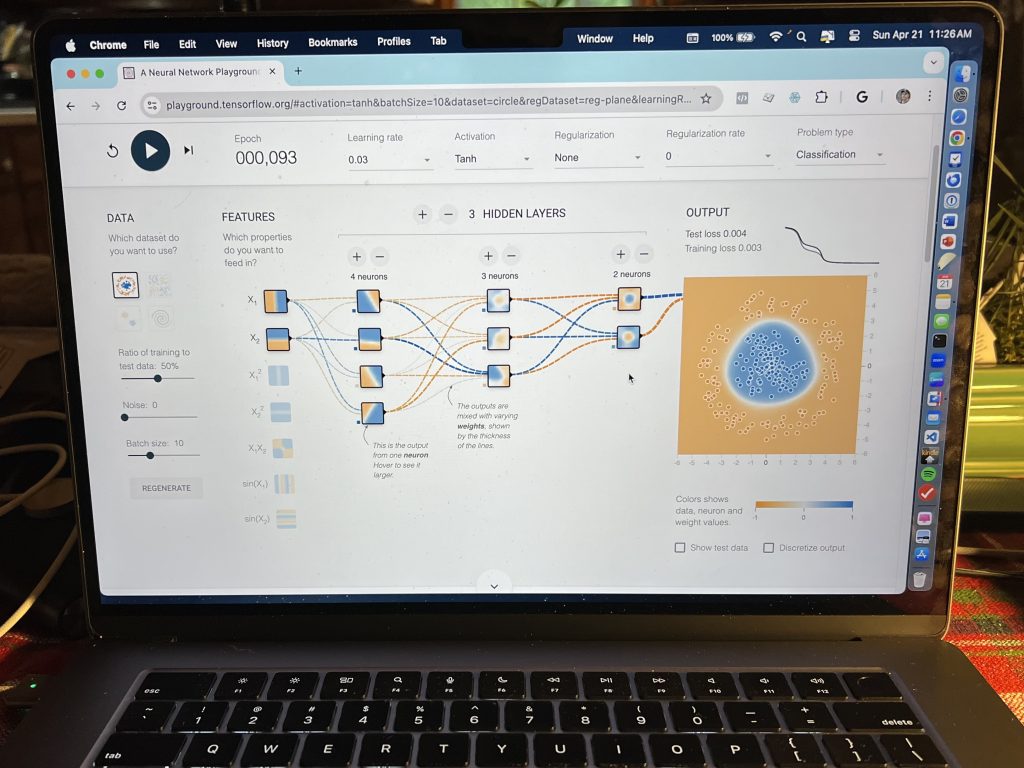
Real-time graphical representation of an Artificial Neural Network (ANN) solving a data classification problem successfully using Deep Learning (DL) via TensorFlow. Photo/Joe Domaleski
Before diving in, it may be useful to understand the differences between the terms: Artificial Intelligence (AI), Machine Learning (ML), Artificial Neural Networks (ANN), and Deep Learning (DL). Here’s an excellent, very readable overview from IBM. These terms are related and often co-mingled, but they are quite different. For purposes of this article, we’ll just stick with AI as an umbrella term.
If you missed my original story from last fall, here are some of the key points:
- ChatGPT is OpenAI’s Generative Pre-trained Transformer AI offering that can generate content using a chatbot interface. It continues to dominate the personal, desktop use of general-purpose AI. It runs in a browser and as a mobile device application.
- Ways that I used AI last year included: research, idea generation, proofreading, problem-solving, and data analysis.
- Prompts are used to make requests of AI technology typically using a chat interface and work best when you provide both context and direction.
- AI has some big drawbacks, and because of that, I do not recommend using it for sensitive data processing, long-form written content, or image/video creation by itself. Use it like a personal assistant.
Although AI has been around since the 1950s, it’s had an up-and-down history over the years with failed promises. About ten years ago, the “AI winter” began to thaw, and things started to come together as AI began to show up in our phones and computers embedded as voice recognition, image identification, route planning, spell checking, translation systems, and recommendation engines. Most people referred to these systems as “smart” or “intelligent” without specifically using the term AI, which had somewhat of a checkered history of hype. All of that changed at the end of 2022.
When OpenAI launched ChatGPT 3.5 at the end of 2022, it introduced the world to generative AI, in which your computer could seemingly write and create images for you automatically. Everything changed, and AI reached mass awareness in 2023. Even though it was already in many of our phones and computers, most people didn’t take notice. As the biggest tech launch of all time, ChatGPT allowed all of us to dabble in computer-generated writing and image creation exercises. ChatGPT’s emergent, generative capabilities caught everyone off guard, including the team that created it.
Admit it, you created something with ChatGPT last year and amazed your friends with what it could do. My article last year was an attempt to put some realism into how one might use AI because it can’t do everything. If 2023 was the year of generative AI emergence, what’s ahead for the future?
In order to answer that question, I’ve spent the last six months stepping up my research and use of AI because I’m the type of person who likes to know how things work. Over the winter, I enrolled in several online courses, including some post-graduate classes, to update my knowledge with the tools and techniques of AI including Python programming, machine learning algorithms, statistics, linear algebra, data science, R programming, and data analytics. I even wrote my own AI program on an iPad to do image recognition.
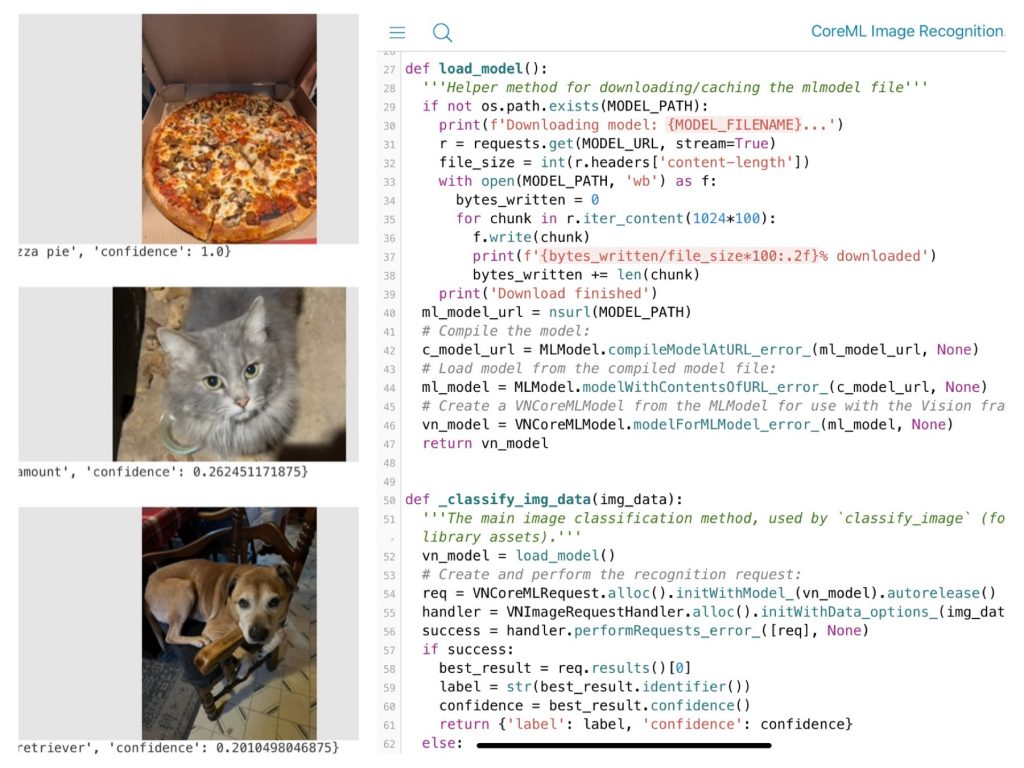
AI program written in Python that is running on an iPad to demonstrate Machine Learning (ML) image recognition of pictures from my photo roll. It got the pizza correct but wasn’t able to determine the breed of my cat or dog (hence the low confidence percentage). Photo/Joe Domaleski
In addition to the technical courses, I’ve also studied what the leading business schools are saying about AI and business. Here’s some recent non-technical books I’ve read and recommend for business professionals and those with an interest in the current state of AI:
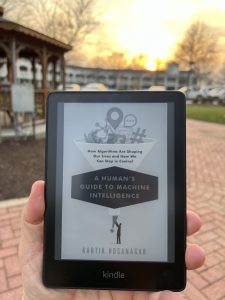
Reading the Kindle version of A Human’s Guide to Machine Intelligence by Dr. Kartik Hosanagar during the sunset in downtown Fayetteville, GA. Photo/Joe Domaleski
- The Worlds I See by Dr. Fei-Fei Li of Stanford. Considered one of the leaders in AI image recognition, Dr. Li has written a very readable book that I couldn’t put down. It not only gives an insider view into the emergence of computer vision but also tells the story of how a female Chinese immigrant succeeded in male-dominated engineering. Highly recommended for everyone, but especially for young women pursuing STEM careers.
- A Human’s Guide to Machine Intelligence by Dr. Kartik Hosanagar of Wharton. This is a great book that explains how AI and algorithms are used in business and society. I was inspired to read this book after taking Professor Hosanagar’s excellent AI and Business course through the Wharton Business School. He has a knack for taking complex ideas and simplifying them and making them relatable.
- Co-Intelligence by Dr. Ethan Mollick also of Wharton. If you only have time to read one book about AI, this is the book to read. Co-Intelligence is brand new and just came out earlier this month (April 2024). This book should be required reading for today’s business leaders. Professor Mollick used AI to help co-write the book and documents the process. This is a first hand account of how someone actively uses AI – the good and the not so good. In the book, Mollick encourages us to consider AI as a co-worker and collaborator. It’s both entertaining and thought-provoking.
So, what’s new in AI in 2024? If 2023 was the year of awareness and hype, 2024 will be the year of more realistic expectations. Earlier this year, I wrote about important trends for small businesses in 2024, quoting an IBM study that emphasized, “People who use AI will replace people that don’t.” Almost five months in and that’s proving to be very true.
No matter where you’re at in your career, knowing how to properly use AI is going to be an essential skill for the future. It won’t be good enough that you can write or create simple images with AI – everyone can do that now. It’s assumed knowledge that everyone knows how to use an AI prompt. We’re moving from the “what” to the “so what”. The modern business professional will need to know how to properly use AI by considering such factors as:
- Myth vs. Reality – there’s a lot of AI hype right now and almost every software product I use purports to have an embedded AI feature, even my invoicing system. What type of AI is being used and what exactly is it doing?
- Industry knowledge – AI by itself isn’t very helpful unless you are able to properly prompt it and verify what it generates. This will require industry knowledge to maximize the utility provided by AI.
- Relevance – specifically, how does the AI-generated solution relate to my business, customer, or task that needs to be done?
- Accountability – how trustworthy is the AI generated content and what happens if it’s wrong?
- Authenticity – how well does the AI generated content fit into a human world? Does it look fake and what impact will that have? People like to relate to other people. (NOTE: fellow marketing companies, please stop with the fake abstract AI images already.)
- Security – data security is already a problem with all computer systems, so how will AI handle confidential information put into its “black box”?
- Explainability – just having the answer isn’t enough, how well can AI explain how it arrived at its conclusions?
- Bias – there’s been some well documented situations of bias in AI-generated content. How can one reduce bias without overcompensating?
- Cost – billions of dollars are being poured into AI-solutions. What is the ROI for an AI project?
- Maintenance – I recently read that some AI systems are running out of new data to process. Society is building all of these AI systems, but how are they going to be maintained in the future?
- Offline AI – most AI system require a persistent internet connection. Two months ago AT&T had a massive network wide failure when their cell network was offline for more than eight hours. What happens to critical AI systems when the Internet is not available.
- Creativity – maybe the most essential question related to AI. Are AI systems creative and how can we tap into that power? I partially answered that question in this article about the importance of creativity.
Armed with the above knowledge and considerations, here’s what I see ahead in 2024 with AI, particularly with small businesses like mine:
- Even more AI hype – admittedly, there’s no agreed upon definition of what artificial intelligence is. Because it’s trendy, even more companies are going to jump on the AI bandwagon by repackaging existing products & services with the AI label. Trends come and go, so I would use caution in overusing the AI term which may fall out of fashion later.
- Increase of embedded AI systems – this is already happening and likely to increase this year. It’s widely expected that Apple is going to make some significant AI announcements for its products in June 2024 (we’ll check back later to see if that happens). Right now, voice and keyboard chat are the two main ways to interact with AI. This is likely to grow into new ways to leverage AI as it gets embedded into more systems.
- More generative AI options – ChatGPT stole the show in 2023, but newer systems are emerging such as Microsoft CoPilot (formerly Bing AI), Google Gemini (formerly known as Bard), and Meta AI (built on LLAMA-3) to name a few. Speaking of names, the tech giants are struggling with the branding of their AI tools so watch out for name changes.
- Growing gap between AI users and non-users – it’s not lost on me that it’s fashionable to position oneself as a technical Luddite especially in many executive circles. Someone recently told me that they were glad they retired before the AI revolution. The business leaders of the past could get away with that. Leaders of the future can’t and are already putting AI to good use, creating efficiencies that were unthinkable in the past. Results-oriented leaders of today will use AI, just as the leaders of yesterday used personal computers. AI has the potential to democratize information, so don’t get left behind.
- Increase in AI legal and ethical concerns – it’s fairly well known that laws struggle to keep up with technology. It’s taken decades for the Internet to be regulated – some say it’s regulated too much and others not enough. There’s almost no regulation of AI right now. Moreover, it’s being dominated by a handful of companies. Is that good or bad?
- Big changes ahead for internet search – Keep an eye on this one business leaders, particularly with regards to your marketing. Google totally dominates the search for information, products, and services online. Although search is free, advertising on Google is not. Search Engine Marketing (SEM or Pay-Per-Click) is one of the top ways for a business to get noticed online. This aspect of search is heavily monetized by providing revenue for Google and advertising opportunities for businesses. So far, AI like ChatGPT doesn’t have ads. Many consumers are looking up things on AI instead of doing traditional Google searches. Google is scrambling to adapt. What is already starting to happen is a morphing of the two technologies as frameworks like Google Search Generative Experience (SGE) continue to evolve. What does this mean for the consumer trying to buy products & services as well as the business who is trying to market to those consumers? We don’t know yet, but be prepared for change!
Looking ahead for the remainder of 2024, I still believe that the practical and thoughtful application of AI will be of great benefit, particularly to small businesses. It’s already been a big help to us. Apparently, I’m not the only one interested in how AI can be used by small businesses. If you’re a business owner, you’re familiar with the mandatory Business Trends and Outlook Survey (BTOS) from the US Census Bureau. If not, then you should know it’s a required government survey that businesses must complete to develop insights into the state of the economy. The last several versions of the survey have included AI-related questions such as this one:
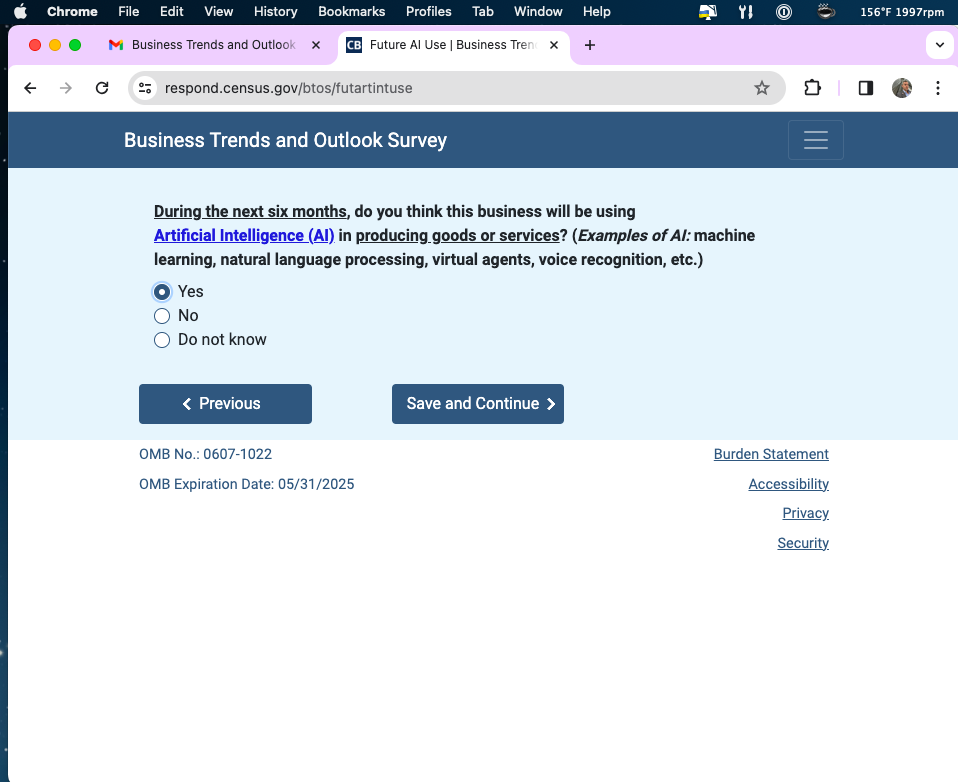
US Census Bureau Business Trends and Outlook Survey (BTOS) question about AI from March 2024. Photo/Joe Domaleski
Big business has been using AI for years, but now it’s affordable and available to the smallest of businesses. I don’t have a human personal assistant and never have. At this point in my career, I’m not sure I need one. AI helps me analyze data, schedule meetings, look things up, summarize information, and think through ideas—much like a human assistant. Understanding how it works, what I can do with it, and where the technology is going ensures that my team and I use it ethically to improve efficiency, innovation, and helpfulness in the work that we do for our customers. Equally important is knowing when not to use it. Churning out AI-generated content is unimaginative and rarely produces the desired results. Human-centric creativity supported by AI is the way of the future. How do you plan to use AI this year? (PS – We’re working on a small-business focused AI offering under the label of “Country Fried Labs” so stay tuned for more about that later this year!)
[Joe Domaleski, a Fayette County resident for 25+ years, is the owner of Country Fried Creative – an award-winning digital marketing agency located in Peachtree City. His company was the Fayette Chamber’s 2021 Small Business of the Year. Joe is a husband, father of three grown children, and proud Army veteran. He has an MBA from Georgia State University and enjoys sharing his perspectives drawing from thirty years of business leadership experience. Sign up for the Country Fried Creative newsletter to get marketing and business articles directly in your inbox. You can connect with Joe directly on LinkedIn for more insights and updates.]
by Joe Domaleski | Apr 16, 2024 | Blog, Business, Columnists, Community, Front Page, News Center, Opinion, Top News
When I look back over my accomplishments and failures in life, two things seem to have made the most impact on determining success or failure: attitude and pace. Both of these factors are entirely manageable. Don’t get me wrong—external factors can impact how things turn out, but in many cases, external forces can be overcome with a positive attitude and a proper pace.
I’m writing this article the day after the 2024 Boston Marathon. I ran my first Boston Marathon back in 1998 and often consider the connections between running and life. A runner toeing the starting line of a race has to believe (attitude) they can reach their goal and they have to set a proper tempo to make it to the finish line without going too fast or too slow (pace). Let’s consider what this means in your business and personal life.

My first Boston Marathon on Patriot’s Day – April 20, 1998. Yes, I celebrated my completion of the race with a cigar! Photo/Joe Domaleski
You’ve probably heard it before, but attitude is everything. A good leader needs to believe success is possible and convey that hope and optimism to his/her team. I’ve written previously about being a leader of hope. Having a positive attitude doesn’t mean one should ignore risks, resource constraints, and reality. It does mean that oftentimes human beings have the ability to transcend limitations with the proper mindset. Like most entrepreneurs, I started my business with the expectation of success, despite the inherent risks.
Setting a proper pace ensures that forward progress is maintained without going too fast and burning out. Equally as important is to ensure that the pace is swift enough that things don’t drag out causing a loss of motivation. An effective leader, like an orchestra conductor, knows how to set the proper tempo to ensure that everyone maintains the right speed. Because people tend to naturally move at different paces, it’s not always easy to keep everyone together. Some people are like great sprinters who have raw speed, but they have a hard time maintaining consistency over a long haul. Others, myself included, tend to be distance runners who don’t move as fast as the sprinters but we can stay the course for a long time. Finding the balance between speed and endurance can be tricky at best.
You’ve probably seen the funny “Six Phases of a Project” list that’s been around since the late 70s. Although its origins are lost to time, I thought it might be fun to consider each of the phases in both a funny and practical way. Whether it’s a specific project, campaign, or task you’re trying to accomplish, I think this list is relevant.
- Enthusiasm – as mentioned above, most endeavors start with enthusiasm and belief that success is possible, even if there’s not a clear path on how to do it. Although “pain avoidance” is sometimes a motivating factor to get something done (i.e. “choosing the lesser of two evils”), it’s generally better to aim for a more positive outcome fueled with enthusiasm.
- Disillusionment – most worthwhile projects encounter one or more periods of disillusionment fueled by FUD – fear, uncertainty, and doubt. Sometimes FUD can lead to a failure to even get started. Rarely do things go according to plan and that’s when one’s resolve is tested. Change fatigue, missed details, and uncomfortable situations can contribute to disillusionment. The way to combat disillusionment is to “rally the troops” and recommit to the objective. Disillusionment is fixable.
- Panic – sometimes disillusionment can lead to panic. Whereas disillusionment is usually temporary discomfort, panic is the genuine fear of failure. The key word is “fear” – whether it’s based on reality or just perception. At the panic stage, people tend to become less rational and make emotionally charged decisions. If it’s truly a panic situation, the leader needs to intervene and make changes. Changes may include slowing down the pace, changing the staff assignments, recalibrating the objectives, or adjusting the amount of resources. Equally important to the changes is the leader’s commitment and enthusiasm that success can be achieved. If the leader doesn’t believe in success, no one on the team will believe it. In rare cases, it may be time to “abandon ship” if everyone involved agrees the situation isn’t tenable. Very rarely have I seen this type of situation and, quite the contrary, I most often see people giving up when they’re on the cusp of victory.
- Search for the guilty – when things begin to drift and stray from the plan, people tend to ascribe blame. A true leader accepts responsibility for a negative situation. A weak leader blames other people or circumstances. Unfortunately, this is all too common in today’s society. Everyone wants to have a scapegoat. If you are enthusiastic about the end goal and you’re running a proper pace towards a realistic objective, my advice is to stay the course and avoid the blame game. Make needed changes to overcome obstacles, but avoid the “blame game”.
- Punishment of the innocent – this doesn’t always happen, but when it does it’s a real head scratcher. Unfortunately, there’s a natural human tendency to criticize and even blame the person (or team) who’s actually in the “battle” trying to do the right thing. This can happen when someone in an organization has enough clout or status that they can transfer blame from themselves to others in a “trickle down” effect. When this happens, it’s hard to maintain enthusiasm and pacing for a project – or any future endeavors with the same so-called leader.
- Praise for those not involved – this is probably my biggest pet peeve – attention and glory “hogs”. Unfortunately, this happens all too often. I really enjoy hearing about people and teams that overcome adversity to achieve great things. They should receive the praise and attention. Unfortunately, oftentimes we just hear or see about the figureheads who show up when it’s picture time. You know what I’m talking bout, it happens all of the time. Someone will get the overall credit and praise, even if their only contribution to the effort was their “status” in the community. A true leader puts their team on the winner’s platform, not himself or herself. It’s hard to be enthusiastic or stay in the game when the accolades are awarded to non-participants.
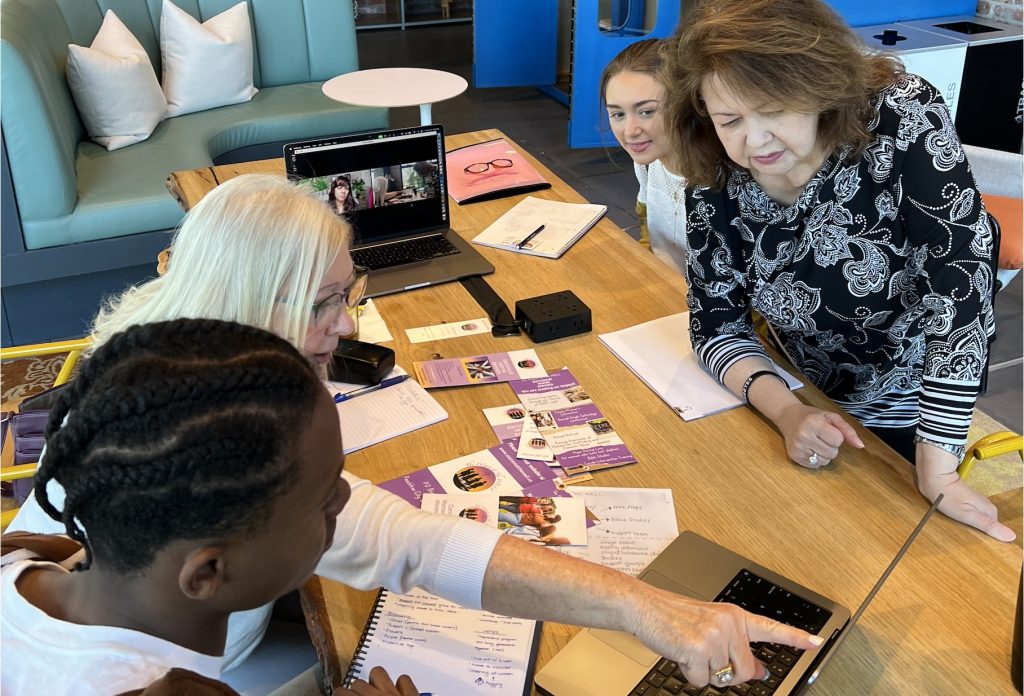
Enthusiastic branding project kick-off for the Women at the WELL ministry. (L-R) Zavion Green, Debbie Gronner, Janine Baggett (via Zoom on the laptop), Mia Scarbrough, and Marta Fewell. April 11, 2024 at Trilith. Photo/Joe Domaleski
In order to cross the finish line in a marathon or complete a project at work, it’s been my experience that a combination of enthusiasm and pacing can mean the difference between success or failure. Be the type of leader who sets worthwhile goals and enthusiastically leads the way. Ensure you and your team are keeping a realistic pace by not running too fast or too slowly. When things don’t go as planned, avoid placing blame on anyone but yourself. Make needed changes, but stay in the race if it’s winnable. Seek out opportunities to praise your team and spotlight their accomplishments, not your own. If you do these things, your team is more likely to help you tackle bigger and better things in the future. How’s your enthusiasm and pace holding up out there?
[Joe Domaleski, a Fayette County resident for 25 years, is the owner of Country Fried Creative – an award-winning digital marketing agency located in Peachtree City. His company was the Fayette Chamber’s 2021 Small Business of the Year. Joe is a husband, father of three grown children, and proud Army veteran. He has an MBA from Georgia State University and enjoys sharing his perspectives drawing from thirty years of business leadership experience. Sign up for the Country Fried Creative newsletter to get marketing and business articles directly in your inbox. ]
by Joe Domaleski | Apr 9, 2024 | Blog, Business, Columnists, Community, News Center, Opinion, Top News
Where were you during the great solar eclipse of April 8, 2024? I spent the afternoon in Fayetteville at our remote office located in the Town of Trilith. We were blessed with a nearly cloudless sky, creating the perfect conditions to see the solar eclipse in which the moon passes between the sun and Earth. Although not full totality from my location, we did have about 82% blockage of the sun.
Around 2:30pm, I stepped outside to view the eclipse. My immediate impression was that nothing was different other than noticing others looking up at the sun with special glasses, looking like moviegoers at a 3D movie. Moviegoers at Trilith? How befitting with the studio complex directly across the street. The irony is not lost on me, and I’m a movie fan myself.

The author viewing the solar eclipse from Trilith on 4/8/2024. Photo/Joe Domaleski
I had enough common sense not to stare up at the sun without protection, so first I decided to try my polarized sunglasses (please do NOT do this, I later found out that even properly rated “regular” sunglasses don’t offer enough protection). It didn’t matter anyway because the sun was so bright I couldn’t look at it even with the sunglasses on – no eclipse.
Next, I took out my solar eclipse glasses. They looked like 3D glasses, as noted previously. The lenses were very darkly tinted, so much so that I couldn’t see anything with them. With my cardboard solar eclipse glasses on, I gazed up towards the sun. Wow! I could see the outline of the moon covering up about 1/3 of the sun. That’s all I could see with these filtered glasses. As soon as I looked away from the sun and took them off, it was a regular bright sunny spring afternoon. I shared my glasses with some other bystanders who were equally amazed.
After sharing my glasses, I put them back on and sat in one of the nearby Adirondack chairs and spent the next 30 minutes watching the moon slide across the sun. It was amazing. Around 3:05 pm, the peak totality of 82% for our area was achieved. Without the glasses, it was like an ordinary day except it seemed like the sun was filtered a little as if there were clouds, even though there weren’t any clouds. With the filtered glasses on, it was a totally different experience.
Filters are good and sometimes very necessary tools in life. We often talk about getting the unfiltered truth or data as if that’s always desired, but sometimes information can only be seen with a filter – much like the solar eclipse. Ask any photographer about the importance of filters. I spent the evening thinking about filters, which inspired this article. Just as my solar eclipse glasses were used to filter out harmful rays and allow the eclipse to be seen, businesses need filters to help discern and prioritize important information while minimizing distractions and even risks.
Here are some types of filters that I find useful in business:
- Information filtering – As a business leader, I’m simply drowning in information. Much has been written about information overload, and I know I’m not unique in this regard. One can simply spend all day trying to stay “in the loop” without actually doing anything. I often filter information by carefully using summaries. Every business presentation should have an Executive Summary. Do you use spreadsheets? Me too. The Filter function in Microsoft Excel is a lifesaver.
- Email / message filtering – Like you, I’m also overwhelmed with communications via emails, text messages, app alerts, phone calls, etc. I try to be very responsive, but I also have to be selective in processing communications. I filter my digital inbox using email and messaging rules so that the truly important stuff bubbles up to the top. Other stuff is still accessible when I have time to get to it. Family always gets top priority followed by my staff at work. I tell clients that they can always contact me directly via phone or text message to bypass the filter, but only if it’s an emergency. Most of my work filtering is done on purpose in order to ensure things are handled properly by the right people, which isn’t always me. If people go straight to me, I can become a bottleneck and I don’t want that.
- Opportunity filtering – One of my most important functions as a business leader is new business development. I’ve written previously about the importance of sales, but I also know that not every new opportunity is something to consider. On a daily basis various and sundry businesses are either trying to sell me things -or- buy my business. I have to filter those opportunities or else I’d be wasting my time and theirs.
- Decision filtering – Not every decision needs to be made by me, nor is every decision something that needs to be made immediately. Sometimes delaying a decision will cause the issue to resolve itself or by someone better equipped to handle it. In general, I believe decisions should be made at the lowest level in an organization where it makes sense. Doing so promotes empowerment and responsibility. If something makes it through the filters up to me, then my expectation is that it’s something that warrants my personal attention.
- News filtering – Recently I wrote a piece about where I get my news and the importance of getting it from a wide variety of sources. While it’s important to gain insights from a variety of perspectives, it’s also necessary to filter some of the news sources so that no one source or topic becomes dominant. I filter my news by source, topic, and format. I get headline news on my iPhone and Apple Watch, which keeps me dialed into breaking news. I read the news on my iPad and laptop for a deeper dive. Filtering allows me to focus on what’s important.
- Emotional filtering – Most of the filtering I’ve mentioned so far is fairly objective based on easy-to-define criteria. Emotional filtering is very subjective. As humans, we are emotional and moody creatures. Expressing emotions and allowing others to do the same is something uniquely human and not something that’ll be replaced by Artificial Intelligence (AI). Discretion is often needed to filter out unproductive emotions or ones that may be harmful to others. It’s also important when someone else is being emotional to react appropriately and apply a meaningful and compassionate filter in order to see things in a proper light.
- Time filtering – How I choose to spend my time is perhaps the most important decision I make as a leader. Time management is a personal decision informed by a number of factors. Being able to filter my time by priority, importance, and urgency allows me to be more effective overall so that the “squeaky wheel” isn’t the only thing getting attention. I personally use my Apple Calendar which syncs across all of my devices and has a handy filter option to help me manage my time. Filtering my time ensures I live a well balanced and productive life each day.
Solar eclipses are truly magical events, and the next one doesn’t happen for another 20 years here in North America. Assuming I’m still around, I can’t wait until it happens again. For a brief two-hour block of time, many people stopped what they were doing to view the eclipse. Many schools and local organizations had special viewing events. Sporting events stopped so that people could view it. I even encouraged my staff to go outside and safely view the eclipse. I read a statistic from Cloudflare that suggests that Internet traffic decreased by 50% in some locations during the eclipse event. Yet, the eclipse was only viewable with specially filtered glasses. To see the eclipse, a filter was necessary to not only protect my eyes but also to see the eclipse itself. When properly used, filters can promote efficiency, focus, empowerment, and risk mitigation. Whether you’re looking at a solar event like the eclipse or trying to focus in a busy world, filters can go a long way in ensuring clarity.
[Joe Domaleski, a Fayette County resident for 25 years, is the owner of Country Fried Creative – an award-winning digital marketing agency located in Peachtree City. His company was the Fayette Chamber’s 2021 Small Business of the Year. Joe is a husband, father of three grown children, and proud Army veteran. He has an MBA from Georgia State University and enjoys sharing his perspectives drawing from thirty years of business leadership experience. Sign up for the Country Fried Creative newsletter to get marketing and business articles directly in your inbox. ]





















